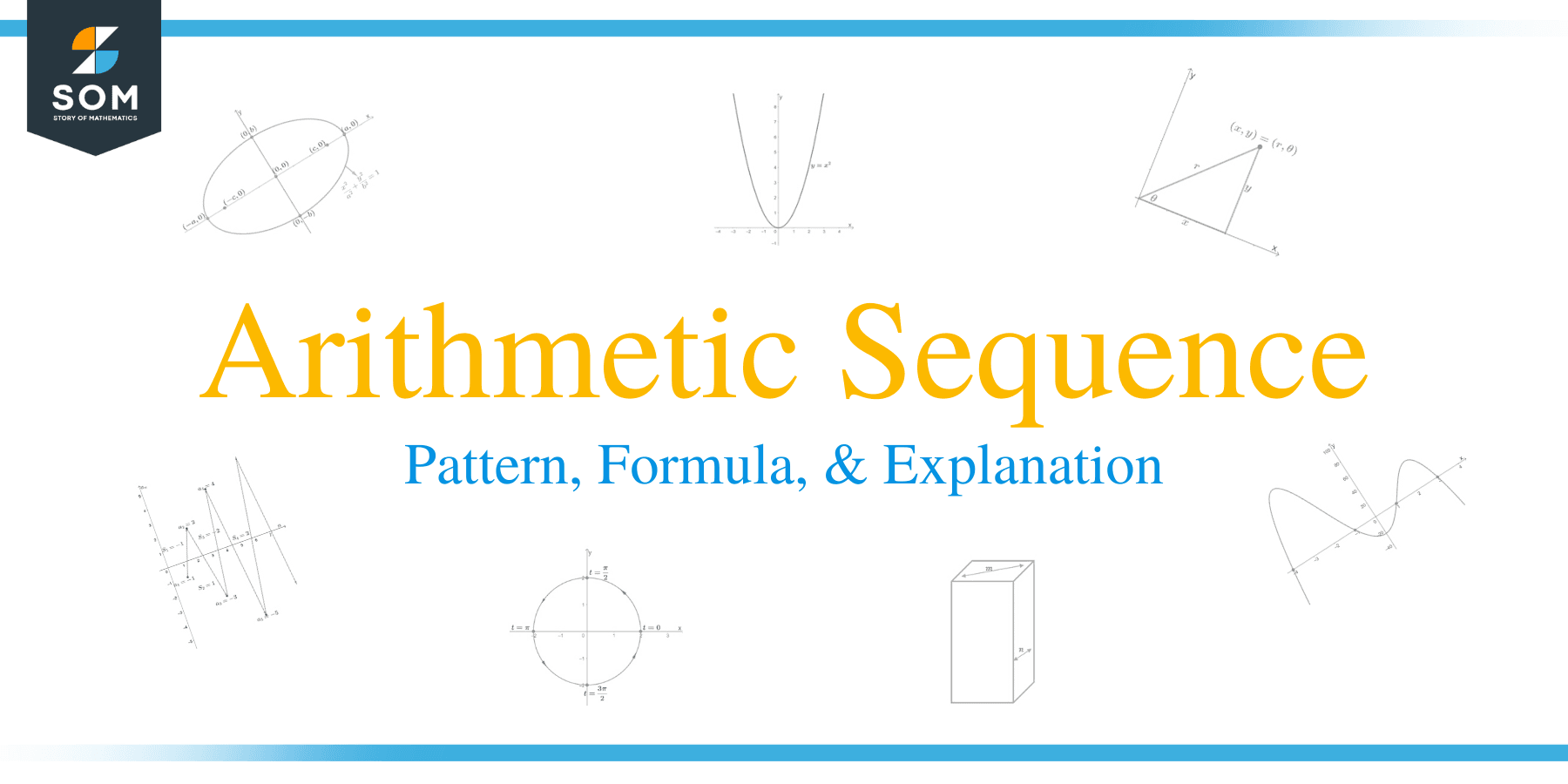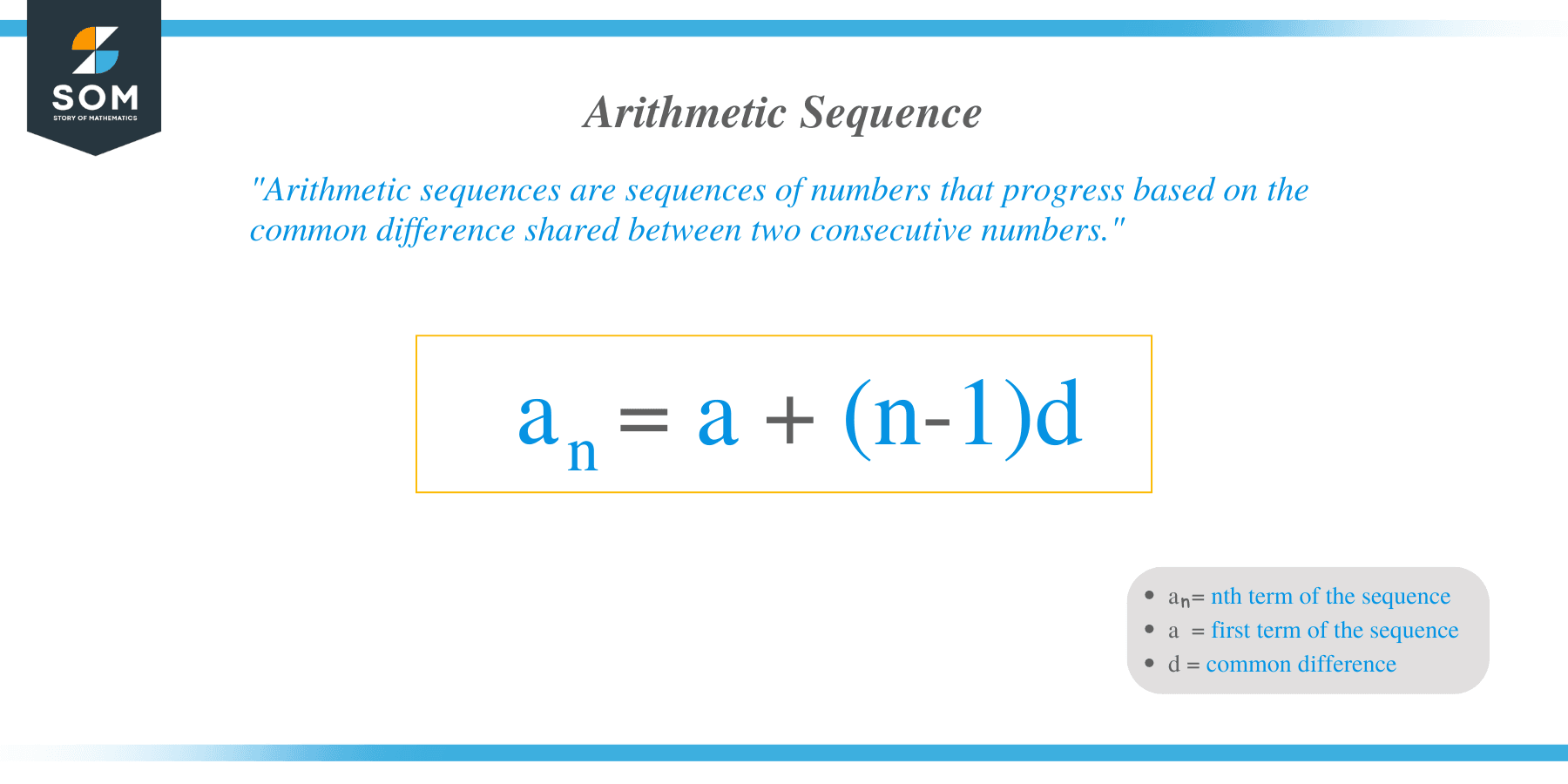- Home
- >
- Arithmetic sequence – Pattern, Formula, and Explanation
JUMP TO TOPIC
Arithmetic Sequence – Pattern, Formula, and Explanation
 Whether we’re aware of it or not, one of the earliest concepts we learn in math fall under arithmetic sequences. When we count and observe numbers and even skip by $2$’s or $3$’s, we’re actually reciting the most common arithmetic sequences that we know in our entire lives.
Whether we’re aware of it or not, one of the earliest concepts we learn in math fall under arithmetic sequences. When we count and observe numbers and even skip by $2$’s or $3$’s, we’re actually reciting the most common arithmetic sequences that we know in our entire lives.
Arithmetic sequences are sequences of numbers that progress based on the common difference shared between two consecutive numbers.
This article will show you how to identify arithmetic sequences, predict the next terms of an arithmetic sequence, and construct formulas reflecting the arithmetic sequence shown. We’ll also learn how to find the sum of a given arithmetic sequence.
Let’s go ahead first and understand what makes up an arithmetic sequence.
What is an arithmetic sequence?
Arithmetic sequences are sequences of number that progress from one term to another by adding or subtracting a constant value (or also known as the common difference). Let’s observe the two sequences shown below:
\begin{aligned} 2^{\color{green}\displaystyle{\overset{+3}{\rightarrow}}} 4^{\color{green}\displaystyle{\overset{+3}{\rightarrow}}} 7^{\color{green}\displaystyle{\overset{+3}{\rightarrow}}} 10^{\color{green}\displaystyle{\overset{+3}{\rightarrow}}} 13^{\color{green}\displaystyle{\overset{+3}{\rightarrow}}} 16…\\ 34^{\color{green}\displaystyle{\overset{-2}{\rightarrow}}} 32^{\color{green}\displaystyle{\overset{-2}{\rightarrow}}} 30^{\color{green}\displaystyle{\overset{-2}{\rightarrow}}} 28^{\color{green}\displaystyle{\overset{-2}{\rightarrow}}} 26^{\color{green}\displaystyle{\overset{-2}{\rightarrow}}} 24…\end{aligned}
The two sequences are great examples of arithmetic sequences.
- We can find the next term for the first sequence by adding $3$ to the previous term.
- For the second one, we can see that the terms gradually decrease by $2$.
- The next term can be determined for each sequence by adding (or subtracting) a constant, and the two are arithmetic sequences.
This means that any sequence that reflects a similar pattern will be considered an arithmetic sequence. Why don’t we generalize this rule for all sequences, $\{a_1, a_2, …, a_n\}$?
Arithmetic sequence definition
This means that when we have a sequence, $\{a_1, a_2, …, a_n\}$, in general, it is an arithmetic sequence when:
\begin{aligned} a_2 – a_1 &= d\\ a_3 – a_2 &=d\\ .\\.\\.\\a_n – a_{n -1}& = d\end{aligned}
This means that a sequence is said to be an arithmetic sequence when the difference between two consecutive terms such as $a_1$ and $a_2$, $a_3$ and $a_4$ as well as $a_{n-1}$ and $a_n$ must all be the equal to a constant, $d$.
Let’s go ahead and observe $5, 8, 11, 14, 17, 20, 23,…$.
We can observe the differences between each pair of consecutive terms to confirm if it is indeed an arithmetic sequence.
$8 – 5 = 3$ | $17 – 14 = 3$ |
$11 – 8 = 3$ | $20 – 17 = 3$ |
$14 – 11 = 3$ | $23 – 20 = 3$ |
We can see that each consecutive term skip by $3$:
\begin{aligned} 5^{\color{green}\displaystyle{\overset{+3}{\rightarrow}}} 8^{\color{green}\displaystyle{\overset{+3}{\rightarrow}}} 11^{\color{green}\displaystyle{\overset{+3}{\rightarrow}}} 14^{\color{green}\displaystyle{\overset{+3}{\rightarrow}}} 17^{\color{green}\displaystyle{\overset{+3}{\rightarrow}}} 20^{\color{green}\displaystyle{\overset{+3}{\rightarrow}}} 23…\end{aligned}
This confirms the fact that the sequence is arithmetic.
How to solve arithmetic sequences?
We can find the next term of an arithmetic sequence and even determine the specific formula for a given sequence using the arithmetic sequence’s recursive and explicit rules.
The two forms have their own strengths, and knowing when to use the two can help a lot in addressing what’s needed in a given problem involving arithmetic sequences.
Arithmetic sequence formula
Let’s say we $a_1$ represents the first term of the sequence, $a_n$ be the last term of the sequence, and $d$ be the common difference shared between two consecutive terms from the terms; we have the following arithmetic sequence formulas.
Recursive Rule
\begin{aligned}a_n = a_{n-1} + d\end{aligned}
This form of the arithmetic sequence formula is most helpful when we’re looking for the $n$th term of a given arithmetic sequence.
For example, if we have $-5, 0, 5, 10, 15, 20…$, we can use the recursive formula to find the next term.
- The common difference shared by two consecutive terms will always be $5$.
- This means that the seventh term, $a_7$, will be equal to $20 + 5 = 25$.
Explicit Rule
\begin{aligned}a_n = a_1 +(n -1) d\end{aligned}
This form is most helpful if we want to find the formula representing the arithmetic sequence. Using the same example, $-5, 0, 5, 10, 15, 20…$, we can use the explicit rule to find the sequence’s general rule.
We have $a_1 = -5$ and $d = 5$, so we can replace the general rule and simplify the right-hand side to find the general rule for $n$.
\begin{aligned} a_n &= -5 + (n- 1)5\\&= -5 + 5n – 5\\&=5n – 10\end{aligned}
With the explicit rule or form, we can also predict the $100$th value of the sequence by substituting $ n = 100$ into the formula.
\begin{aligned} a_{100} &=5(100) – 10\\&= 500 – 10\\&= 490\end{aligned}
How to find the sum of the arithmetic sequence?
When dealing with arithmetic sequences, it’s also helpful to learn about arithmetic series.
Arithmetic Sequence | $a_1, a_2, a_3, …, a_n$ |
Arithmetic Series | $a_1+ a_2+ a_3+ …+ a_n$ |
The only difference between arithmetic sequences and series is that arithmetic series reflects the sum of an arithmetic sequence.
We can find the sum of an arithmetic sequence or the value of an arithmetic series by finding the average of the first and the last term then multiplying the result by the number of terms.
This means that given $a_1$ and $a_n$, the sum of the sequence (or the value of the arithmetic series) is equal to $S_n = \dfrac{n(a_1 + a_n)}{2}$.
Let’s say we want to find the sum of the series, $7 + 14 + 21 + … +70 + 77$, it’s important that we check if the series is indeed an arithmetic series
\begin{aligned} 7^{\color{green}\displaystyle{\overset{+7}{\rightarrow}}} 14^{\color{green}\displaystyle{\overset{+7}{\rightarrow}}} 21^{\color{green}\displaystyle{\overset{+7}{\rightarrow}}} … 63^{\color{green}\displaystyle{\overset{+7}{\rightarrow}}} 77\end{aligned}
We have confirmed that the sequence is arithmetic and $d = 7$, so we can use the formula for the sum of an arithmetic series by first finding the value of $n$.
Using the explicit rule of an arithmetic sequence, we have the following:
\begin{aligned} a_n &= a_1 + (n-1)d\\77&= 7 + (n-1)7\\11&=1 + (n-1)\\n&=11\end{aligned}
Now that we have $a_1 = 7$, $a_n = 77$, and $n= 11$, we can use the sum formula to find the value of the arithmetic series.
\begin{aligned} S_n &= \dfrac{n(a_1 + a_n)}{2}\\&= \dfrac{11(7 + 77)}{2}\\&= \dfrac{11(84)}{2}\\&= 11(42)\\&= 462\end{aligned}
This means that we can use the different elements and formulas involving the arithmetic sequence to solve different types of problems. Make sure to review the different rules and formulas before trying out these problems shown below!
Example 1
Determine whether the sequences below are arithmetic sequences or not.
a. $3, 9, 15, …, 75, 81$
b. $-12, -6, 0, …, 60, 66$
c. $2, 4, 8, …, 256, 512$
d. $2, 5, 8, …, 71, 75$
Solution
To confirm whether a sequence is an arithmetic sequence, we can check the sequences’ patterns and see if each pair of consecutive terms shares a common difference. If they do, the sequence is considered an arithmetic sequence.
\begin{aligned} 3^{\color{green}\displaystyle{\overset{+6}{\rightarrow}}} 9^{\color{green}\displaystyle{\overset{+6}{\rightarrow}}} 15^{\color{green}\displaystyle{\overset{+6}{\rightarrow}}} … 75^{\color{green}\displaystyle{\overset{+6}{\rightarrow}}} 81\end{aligned}
We can see that the first sequence share a common difference of $6$, so the given sequence is an arithmetic sequence.
Applying the same process for the next sequence, we have the following:
\begin{aligned} -12^{\color{green}\displaystyle{\overset{+6}{\rightarrow}}} -6^{\color{green}\displaystyle{\overset{+6}{\rightarrow}}} 0^{\color{green}\displaystyle{\overset{+6}{\rightarrow}}} … 60^{\color{green}\displaystyle{\overset{+6}{\rightarrow}}} 66\end{aligned}
Hence, the second sequence is also an arithmetic sequence.
\begin{aligned} 2^{\color{green}\displaystyle{\overset{+2}{\rightarrow}}} -4^{\color{green}\displaystyle{\overset{+4}{\rightarrow}}} 8^{\color{green}\displaystyle{\overset{+8}{\rightarrow}}} … 256^{\color{green}\displaystyle{\overset{+256}{\rightarrow}}} 512\end{aligned}
The differences between the pairs of consecutive terms vary, so the sequence is not an arithmetic sequence.
Let’s now take a look at the last sequence:
\begin{aligned} 2^{\color{green}\displaystyle{\overset{+3}{\rightarrow}}} -5^{\color{green}\displaystyle{\overset{+3}{\rightarrow}}} 8^{\color{green}\displaystyle{\overset{+5}{\rightarrow}}} … 71^{\color{green}\displaystyle{\overset{+4}{\rightarrow}}} 75\end{aligned}
Since the pairs of consecutive terms have varying differences, so the sequence is not an arithmetic sequence.
Example 2
What is the common difference of the arithmetic sequence, $-9, -3, 3, 9, …$? Find the seventh term of the sequence.
Solution
We can start by observing the common difference shared by each pair of consecutive terms.
$-3 – (-9) = 6$ | $3 – (-3) = 6$ | $9 – 3 = 6$ |
This means that the arithmetic sequence has a common difference of $6$. We can use the common difference to find the next terms by adding each term by $6$ until we have the seventh term.
\begin{aligned} a_4&= 9\\ a_5&= 9+ 6\\&= 15\\a_6 &= 15 + 6\\&= 21\\a_7 &= 21 + 6\\&= 27\end{aligned}
This means that the seventh term of the arithmetic sequence is $27$.
Example 3
Find an equation that represents the general term, $a_n$, of the given arithmetic sequence, $12, 6, 0, -6, -12, …$. Use this equation to find the $100$th term of the sequence.
Solution
We can begin by finding the common difference of the arithmetic sequence.
\begin{aligned} 12^{\color{green}\displaystyle{\overset{-6}{\rightarrow}}} 6^{\color{green}\displaystyle{\overset{-6}{\rightarrow}}} 0^{\color{green}\displaystyle{\overset{-6}{\rightarrow}}} -6^{\color{green}\displaystyle{\overset{-6}{\rightarrow}}} -12\end{aligned}
From this, we can see that the sequence has a common difference, $d$, of $-6$. To find the equation representing the $n$th term of the sequence, we can use the explicit rule for the arithmetic sequence, as shown below.
\begin{aligned} a_n &= a_1 + (n-1)d\\&= 12 + (n – 1)(-6)\\&= 12 + (-6n + 6)\\&= 12 – 6n + 6\\&= 18 – 6n\end{aligned}
Now that we have the equation for the $n$th term’s general form, we substitute $n = 100$ into the equation to find the hundredth term.
\begin{aligned} a_{100}&= 18 – 6(100)\\&=18 – 600\\&= -582\end{aligned}
This means that the general form of sequence’s $n$th term is $-6n + 18$, and the $100$th term of the sequence is $-582$.
Example 4
What is the sum of the series $6 + 11 + 16 + 21 + … +216+ 221$?
Solution
\begin{aligned} 6^{\color{green}\displaystyle{\overset{+5}{\rightarrow}}} 11^{\color{green}\displaystyle{\overset{+5}{\rightarrow}}} 16^{\color{green}\displaystyle{\overset{+5}{\rightarrow}}} 21^{\color{green}\displaystyle{\overset{+5}{\rightarrow}}} …,216^{\color{green}\displaystyle{\overset{+5}{\rightarrow}}} 221\end{aligned}
Observing the sequence, we can see that the common difference, $d$, of the series is equal to $5$.
To find the sum of the arithmetic series, we’ll need the first and last terms and the number of terms within the series. Let’s use the explicit rule, $a_n = a_1 + (n – 1)d$, to find the value of $n$ first.
\begin{aligned} a_1 &= 6\\a_n&= 221\\d&= 5\\\\221 &= 6 + (n-1)5\\215&=5(n – 1)\\43&= n – 1\\ n&= 44\end{aligned}
This means that the series has $44$ terms. We can now use the formula for the sum of an arithmetic series since we have $a_1$, $a_n$, and $n$ already.
\begin{aligned} S_n &= \dfrac{n(a_1 + a_n)}{2}\\&=\dfrac{44(6 + 221)}{2}\\&= \dfrac{44(227)}{2}\\&= 22(227)\\&= 4994\end{aligned}
Hence, the arithmetic series has a sum of $4994$.
Example 5
An outdoor amphitheater contains $12$ seats on its first row, $14$ seats on the second row, $16$ seats on the third row, etc. If the amphitheater has twelve rows, how can seats can it accommodate?
Solution
As we can observe, the outdoor amphitheater increases gradually over each row.
\begin{aligned} 12^{\color{green}\displaystyle{\overset{+2}{\rightarrow}}} 14^{\color{green}\displaystyle{\overset{+2}{\rightarrow}}} 16…\end{aligned}
Since each pair of consecutive terms has $2$ as its common difference, we can say that the number of seats for all eighteen rows will reflect an arithmetic sequence.
We’ll need to know the last term of the sequence first, and we can use the explicit rule to find the number of seats in the $18$th row.
\begin{aligned} a_n &= a_1 + (n-1)d \\ a_{18} &= 12 + (18 – 1)2\\&= 12 + 34\\&= 46 \end{aligned}
This means that the $18$th row has $46$ seats. To find the total number of seats, we can find the sum of the entire sequence (or the arithmetic series) using the formula, $S_n = \dfrac{n(a_1 + a_n)}{2}$.
\begin{aligned} 12 + 14 + 16 + … + 46 &= S_n\\&=\dfrac{18(12 + 46)}{2}\\&= \dfrac{18(58)}{2}\\&=9 (58)\\&= 522\end{aligned}
This means that the outdoor amphitheater has a total seat capacity of $522$.
